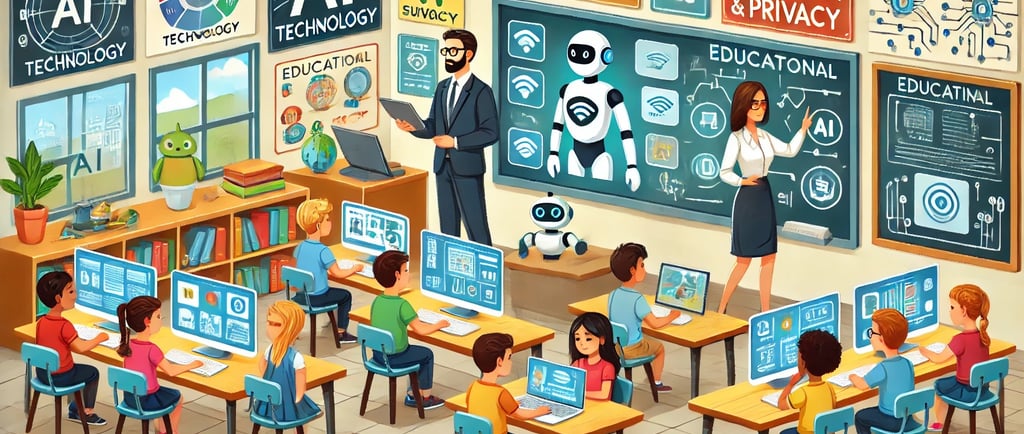Integrating AI in Education: Ensuring Safety, Security, and Student Well-being
"Discover how AI can transform education while ensuring student safety and well-being. Learn essential features, implementation considerations, and advanced tools for integrating AI in schools to create personalized, inclusive, and effective learning environments."
6/28/20243 min read


Safely Using AI in Schools: A Comprehensive Guide for Educators
With the rapid growth of Artificial Intelligence (AI) technology, schools are beginning to integrate AI tools into their educational systems. These tools can offer a variety of benefits, from personalized learning experiences to efficient administrative tasks. However, it's crucial for school leaders to ensure that the use of AI is safe, secure, and beneficial for students. Here's a detailed guide on what to consider when adopting AI tools in schools, along with available tools and resources.
The Promise of AI in Education
Artificial Intelligence (AI) holds immense promise for transforming educational landscapes by offering innovative solutions that cater to the diverse needs of students. Here are the key benefits:
Personalized Learning Experiences: AI-driven educational tools can analyze individual student data to tailor lessons, assignments, and feedback. This personalized approach ensures that each student progresses at their own pace, addressing unique strengths and weaknesses.
Real-Time Feedback: AI tools provide instant analysis of student performance and offer immediate, actionable insights, allowing students to correct mistakes and reinforce learning concepts in real time.
Support for Teachers: AI can automate administrative tasks like grading and attendance tracking, freeing up valuable time for educators to focus on teaching and interacting with students. AI can also help identify at-risk students by analyzing performance and behavior patterns.
Case Study Examples:
California School District: Adopted an AI-driven platform to personalize student learning, leading to improved test scores and student engagement.
UK University: Utilized AI chatbots to provide 24/7 academic support and counseling services, resulting in increased student satisfaction and reduced dropout rates.
Essential Considerations for AI Integration in Schools
1. Transparency for Young Users
For Students Under 13 (Possibly 18): Teachers and administrators must have access to student conversations and transcripts, ensuring transparency and proper monitoring.
2. Effective Moderation Mechanisms
For Students Under 18: AI tools must include mechanisms to prevent and monitor negative use cases like self-harm or hate speech and notify key stakeholders when such situations are detected.
3. High-Quality AI Models
Use high-quality AI models (e.g., GPT-4, Gemini Pro 1.5, Anthropic Claude 3) to minimize errors and hallucinations.
4. Data Privacy and Security
AI vendors must have contracts ensuring student data is not used for training public models and guarantee that data will not be sold to third parties.
Maintain clean SOC-2 audits to ensure robust information security practices.
Prioritizing Student Safety and Security
1. Mitigating Data Breach Risks
Implement encryption, secure password protocols, and regular security audits to protect sensitive student information from breaches.
2. Addressing Privacy Concerns
Establish transparent data governance policies and adhere to legal frameworks like GDPR and FERPA to protect student privacy.
3. Best Practices for Data Protection
Use multi-factor authentication, conduct regular cybersecurity training for staff and students, and employ advanced threat detection systems.
Ensuring Student Well-being
1. Mental Health Support Tools
AI chatbots and virtual counselors can provide immediate assistance to students, identifying those who may be struggling and directing them to appropriate resources.
Combine AI tools with human intervention to offer in-depth, empathetic care.
2. Balanced Approach
Prevent over-reliance on AI by promoting human interaction and setting clear guidelines on AI tool usage.
3. Awareness and Training
Educators and mental health professionals should collaborate to raise awareness about AI's limitations and appropriate uses. Provide training programs for staff and students.
Essential Features for Effective AI Tools in Education
1. Ease of Use
Ensure AI tools have user-friendly interfaces and intuitive designs for seamless interaction by students and educators.
2. Adaptability to Learning Styles
AI tools should cater to different learning styles with personalized learning experiences powered by adaptive algorithms.
3. Alignment with Educational Standards
Design AI tools to meet curriculum requirements and educational benchmarks to support overall educational goals.
4. Complementing Teacher Roles
AI tools should provide insights and analytics that help teachers understand student progress and intervene when necessary.
Additional Features to Enhance the Learning Experience
1. Gamification Elements
Incorporate points, badges, and leaderboards to boost student engagement and motivation through interactive learning experiences.
2. Advanced Analytics for Teachers
Provide deep insights into student performance, helping teachers identify trends and customize teaching strategies.
3. Multi-Language Support
AI-enabled language translation services can promote inclusivity in multicultural classrooms by breaking down linguistic barriers.
Preparing Students for an AI-Driven Future
1. Developing Critical Thinking
Foster critical thinking by encouraging students to evaluate information, question assumptions, and make informed decisions.
2. Enhancing Digital Literacy
Integrate AI concepts into the curriculum to enhance students' understanding and interaction with AI technologies.
3. Emphasizing Ethical Considerations
Instill a strong ethical framework in students to contemplate AI's societal implications and advocate for responsible AI use.
Role of AI in Curriculum:
AI-powered educational tools can provide personalized learning experiences and support differentiated instruction.
Facilitate collaborative learning environments for ethical debates and problem-solving activities.
Conclusion
By implementing these considerations and leveraging available tools and resources, school districts can ensure AI tools are used effectively and responsibly. This approach enhances the learning experience, safeguards student well-being, and prepares students for an AI-driven future.
